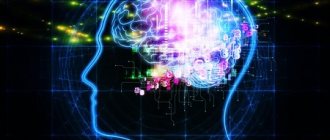Intellectual disabilities in children
The clinical picture of intellectual impairment is varied. Symptoms should be considered in accordance with the classification: with quantitative changes, there is a decrease in learning ability, difficulties/impossibility of self-care, with qualitative changes, a decrease in intelligence is combined with mosaic, partial development of individual functions.
Impaired mental function.
The level of intelligence is below average, reaching levels borderline with mental retardation. There are two variants of the clinical picture. If cognitive activity is impaired due to insufficient development of the emotional-volitional sphere, a lack of interest in cognitive activity comes to the fore: children are active, impulsive, and prefer simple games. They are not interested in creative and educational activities; they are difficult to organize and encourage reading and drawing. The second option is insufficient formation of the prerequisites for intelligence (memory, performance, attention). Children lack initiative, are not independent, are overly active or passive, get tired quickly, work at a slow pace (signs of cerebrovascular disease).
Moronism.
It is characterized by the primitiveness of thinking, its attachment to specific, visual situations, insufficient differentiation of emotions, and weakness of volitional impulses. Patients later master self-care skills, are able to dress independently, and perform hygiene procedures. According to a special curriculum, they master writing, reading, and counting. Teenagers learn simple working professions.
Imbecility.
Thinking is slow, stiff, experience is difficult to adopt. Intellectual-mnestic functions are reduced. Social interaction is limited and learning skills are impossible. Children are delayed in mastering self-care and simple homework.
Idiocy.
Characterized by a lack of speech and the ability to establish productive contact with others (with the exception of single executions of simple commands). There are often concomitant neurological pathologies and diseases of internal organs. Mobility is limited and self-care is not available.
Damaged and deficient development.
The unevenness of intellectual impairments is explained by the mosaic nature of the damage to the central nervous system: some functions are developed and continue to develop at a normal pace, others slow down (depending on the location of the damage - speech, spatial, auditory-verbal perception, memorization). Complex hierarchical connections fall apart, and intellectual retardation develops. Deficient development leads to intellectual impairment based on a primary defect - pathology of the analyzer (hearing, vision), motor system.
Distorted and disharmonious development
. It is caused by an ongoing pathological process that disrupts the uniform development of functions. Children have well-developed verbal intellectual functions, but adaptation is complicated by the difficulty of assimilation and understanding of social rules. Or the child has unique mathematical abilities, but everyday skills are difficult.
Specific intellectual disabilities
There are intellectual impairments that are not related to either dementia or mental retardation. Here is a description of some of them.
1. Fluctuation of productivity. Transient impairment of mental abilities, according to K. Jaspers. The author points out that the concept of “lack of intelligence” makes sense only in conditions of orderly, accessible states, that is, in the absence of acute disorders, during which even an approximate judgment about the patient’s intelligence is impossible. It is not always possible to distinguish a transient disorder from a stable one.
| | Have you noticed an intellectual disability in yourself or a loved one? Call us or sign up online. We will definitely help! |
“Disorders such as decreased mental productivity in intellectuals, artists, or transient, relatively stable and permanent disorders found in psychasthenics present significant difficulties for classification.” The same applies to the phases of affective psychosis, when depressed patients acutely feel their intellectual failure. The loss of productivity in such people can be temporary or long-term. In hypomanic patients, on the contrary, periods of “increased productivity, lush creative flourishing” may occur. “In all such cases,” emphasizes K. Jaspers, “we are not dealing with a change in intelligence as a whole, but only in mental productivity.”
2. Socially determined dementia. It arises “mainly due to the abnormality of the environment in which the patient lives.” K. Bongeffer points out: “Poor upbringing, insufficient education, lack of spiritual and mental aspirations, limited interests in purely material problems, support of the purely vegetative aspect of the Self - all these circumstances can lead to a pronounced lack of knowledge and judgment and to the development of extremely self-centered and morally poor people.” installations." K. Jaspers adds that “we encounter various types of dementia, the causes of which lie in environmental conditions, when dealing with tramps, prostitutes, wealthy rentiers who have not done or experienced anything since childhood, people forced to live for a long time in sanatoriums due to various chronic diseases, as well as all kinds of patients in inpatient psychiatric institutions.”
Socially determined dementia is a concept that makes sense only in relation to children who, from the very moment of their conception, find themselves in extremely unfavorable developmental conditions. We are talking, firstly, not only about their cultural deprivation, but also about the possible influence of a number of other socially determined pathogenic factors (complicated pregnancy, chronic nutritional deficiency, poor care, high rates of injury, illness, insufficient medical care, etc.). P.).
In other words, the resulting mental retardation is caused not only or even not so much by biological, but primarily by other, seemingly external, reasons. It is possible, apparently, to accept the definition of such retardation as intermediate, borderline, that is, located between oligophrenia, on the one hand, and the lower limit of normal mental development, on the other. Secondly, this concept needs clarification with regard to the prevalence, degree of dementia, its dynamics, reversibility, prognosis, and differentiation from mental retardation.
Some cases of socially determined mental retardation are probably closely related to oligophrenia, but in general, all the mentioned and far from simple issues still remain poorly understood. Thirdly, mental retardation may be associated with congenital or early acquired defects of sensitivity, motor skills and speech. Such cases are not directly related to oligophrenia and in this sense are closer, apparently, to socially dependent mental retardation.
Finally, fourthly, and this is obvious, the problem of borderline mental retardation affects many children in different regions of the world and in this regard is no less relevant than the problems of mental retardation and dementia combined. Thus, during autopsies of infants who died of malnutrition in the first year of life, it was found that the total number of brain cells in them was 60% lower than in normal newborns (Winick, 1976). Meanwhile, 40 to 60% of the world's children suffer from mild to moderate malnutrition (Lozoff, 1989), and in some countries, 3 to 7% of children may suffer from severe malnutrition, coupled with a huge number of other potentially dangerous variables (Brozek, Schurch, 1984; Lozoff, 1989). Oddly enough, there are no reliable statistics on borderline mental retardation. According to M. Gross (1948), the prevalence of borderline mental retardation in the population of Scotland is 15.6 per 1000, however, studies of this kind are rare and, moreover, are carried out according to programs based on different conceptual approaches.
Currently, there is no generally accepted term for an unambiguous definition of this pathology. The expression “socially determined dementia” needs, as has been shown, such a large number of clarifications that it hardly has the right to claim the role of a special term. The term borderline intellectual disability by V.V. Kovalev (1979) seems more justified, which the author denotes “states of mild intellectual disability that differ in etiology, pathogenesis and clinical characteristics, occupying an intermediate position between oligophrenia and the intellectual norm.”
Below we present the taxonomy of the disorder proposed by V.V. Kovalev (1973). The author distinguishes the following variants: dysontogenetic forms, encephalopathic forms, intellectual deficiency due to receptoropathy and intellectual deficiency due to defects in education and lack of information. He emphasizes that in each case we can talk about a combination of various factors of the disorder.
1. Dysontogenetic forms of borderline intellectual disability represent various variants of dysontogenesis. The latter are like this.
Intellectual deficiency in states of mental infantilism is “a consequence of impaired maturation of the youngest structures of the brain, mainly the systems of the frontal cortex and their connections, caused by various etiological factors (constitutional-genetic, intrauterine intoxication, toxic-infectious effects in the first years of a child’s life).” The author distinguishes between simple mental infantilism (with a predominance of manifestations of emotional-volitional immaturity) and complicated mental infantilism (with phenomena of psychoorganic syndrome, psychoendocrine syndrome, cerebrasthenic syndrome and symptoms of neuropathy).
Intellectual deficiency with a lag in the development of individual components of mental activity. In this group of disorders, the author includes “intellectual deficiency associated with a partial disruption of the rate of maturation of individual neurophysiological systems: brain mechanisms of speech, psychomotor skills, mechanisms that determine the development of so-called school skills (reading, writing, counting) ... At the same time, the main place in the structure of mental defect is is occupied by the insufficiency of those aspects of cognitive activity that are closely related to functions delayed in their maturation, which differs significantly from a more uniform mental defect with weakness of thinking coming to the fore in mental retardation.”
The following variants of real intellectual development deficiency are distinguished: 1) with delayed speech development, 2) with delayed development of school skills and 3) with delayed development of psychomotor skills.
Distorted mental development with intellectual disability is a variant of early childhood autism syndrome. This refers to cases of early childhood autism with secondary intellectual disability, primarily due to characteristics of personality, speech and motor skills, this, in particular, “insufficient need for contact with others, weakness of motives, emotional inexpressiveness, low speech activity, immaturity of the general and subtle motor skills, as well as lack of active attention.”
2. Encephalopathic forms of borderline states of intellectual disability (“infantile and juvenile organic syndrome” by H. Stutte (1960), “organic defect syndrome” by G. Gollnitz (1970), “minimal brain dysfunction” by Anglo-American authors, “early childhood organic psychosyndrome” "R. Lempp (1974), "syndrome of residual cerebrasthenia with delayed school skills" by S.S. Mnukhin (1968), "functional-dynamic disorders of intellectual activity after infections and injuries" of the central nervous system by G.E. Sukhareva (1965).
According to V.V. Kovalev, “intellectual disability in this group is associated mainly with impairments of intellectual activity and prerequisites for intelligence, caused by residual effects of organic brain damage due to previous brain infections and injuries.” The disorder most often has a functional-dynamic and more or less reversible nature.
The following variants of the disorder are distinguished: 1) cerebrasthenic syndromes with delayed development of school skills, 2) psychoorganic syndromes with intellectual deficiency and impairment of higher cortical functions, 3) borderline intellectual deficiency in cerebral palsy and 4) intellectual deficiency in general speech underdevelopment (alalia syndromes) .
3. Intellectual disability associated with sensory organ defects.
There are two variants of the disorder: 1) intellectual disability with congenital or early acquired deafness and hearing loss and 2) intellectual disability with blindness that arose in early childhood.
4. Intellectual deficiency due to defects in upbringing and lack of information from early childhood (“pedagogical neglect”, “neglect”, “micro-social-pedagogical neglect”, “Mowgli children”). The problem concerns patients who are brought up in families of mentally retarded, primitive and mentally ill parents, in children's institutions, in conditions of neglect.
V.V. Kovalev points out that “intellectual deficiency in these children and adolescents manifests itself in a more or less pronounced lack of knowledge and ideas that a child of a given age should have, with sufficient ability to generalize, the ability to use help in performing certain tasks.” tasks, good orientation in everyday life situations.” The disorder also includes “relatively poor, undeveloped speech, with a predominance of “speech cliches,” poverty of intellectual interests, insufficiency of higher needs and attitudes of the individual.”
3. Relative dementia. It is usually not difficult to distinguish, theoretically, congenital mental retardation from a personality disorder. It is not always possible to do this in practice. There is a type of strange personality in which an outwardly highly developed ability for certain manifestations of intelligence is combined with a striking inability in other respects - relative dementia, according to E. Bleuler. This is a disorder in which, K. Jaspers believes, there is a “disturbed connection between the intellect and the tasks that a person sets for himself.
The disproportion of motives leads to the setting of tasks that a person is not able to cope with at a given level of intelligence.” Such individuals are often endowed with excellent mechanical and verbal memory, but in fact they are “masters of confusion.” They suffer from an incorrigible overestimation of their capabilities, from a complete lack of critical attitude towards themselves and are completely unable to extract from experience instructions that would be useful for the implementation of their tasks.
In their conversations, countless associations flow freely, as they strive to represent something and impress others; hence another name for the disorder: cabin dementia. P.B. Gannushkin prefers the term constitutional stupidity. There is no leap of ideas here, we are talking about something completely different, about a psychologically understandable expansion of the Self, combined with a huge mass of “ideas”, the onslaught of which is limited only by the capabilities of speech activity and mechanical memory. Ideas, however, do not develop; there is nothing in them except manifestations of chaotic and, moreover, completely borrowed from superficial knowledge read.
The place of responsible assessments and attitudes is taken by flat, purely verbal witticisms. The most important thing for the patient is to talk, not to think or think for himself. The first impression that everything said comes from himself is absolutely false. For conversations, the patient prefers to choose “higher” problems, which is why the disorder is also called higher dementia. Judging by this description, we are apparently talking about a psychopathic personality with mixed - hysterical and paranoid - character traits. Like a hysteric, the patient tries to impress others with his extensive knowledge in the field of lofty matters, but at the same time, like a paranoid, he is already confident in his high destiny and therefore is completely devoid of self-criticism. In addition, his cognitive motivation is characterized by immaturity and childishness: he reads or memorizes something not in order to understand something, but mindlessly and haphazardly stores knowledge, mainly in order to tell someone about it, exactly a schoolboy who really wants to get a good grade in class, then brag about it and show it to his strict parents.
4. Emotional dullness and pseudodementia. Mental defect is sometimes identified not only with depression, mild stunned consciousness, subcatatonic states or socio-pedagogical neglect, but also with emotional dullness, that is, indifference, coldness, indifference of patients. This may be associated with almost a loss of cognitive interests, excluding, perhaps, the patients’ elementary motivations that reflect only vegetative needs. Most often in such cases we are talking about patients with a deep schizophrenic personality defect.
The states of pseudodementia, usually observed in so-called prison psychoses, can also be mistaken for a mental disorder. The patient, falling into a state of hysterical psychosis, unconsciously plays the role of a completely helpless person who knows nothing and cannot do anything, who deserves not punishment, but pity and care.
Another form of hysterical reaction is the inability to accept the fact of one’s intellectual failure in a situation of stress - denial of mental deficiency. Patients are somewhat agitated and behave in such a way as to hide their incompetence both from themselves and from others, including the doctor. To this end, they change the direction of the conversation, make inappropriate jokes, talk about something unimportant, thereby diverting their own attention and the attention of others from their mental deficiency.
5. Sunset syndrome. A dementia-like condition characterized by drowsiness, confusion, ataxia, and falls. It is usually observed in older people under the influence of excessive use of sedatives. In addition, the disorder can also occur in dementia patients after taking even small doses of psychoactive substances or under the debilitating influence of bright light, loud noise, or intense communication.
Back to contents
Article:
Concept of the main forms of intellectual impairment
In the clinic, mental underdevelopment is considered as a syndrome of total retardation.
This form of mental dysontogenesis is based on underdevelopment of all aspects of the psyche:
- cognitive processes;
- emotional-volitional sphere;
- personalities;
- need-motivational sphere, etc.
The leading role in the structure of general mental underdevelopment belongs to underdevelopment of cognitive activity. A typical model of mental underdevelopment is mental retardation.
The International Classification of Diseases defines mental retardation as follows:
“Mental retardation is a state of delayed or incomplete development of the psyche, which is primarily characterized by a violation of the abilities that manifest themselves during the period of maturation and provide the general level of intelligence, i.e. cognitive, speech, motor and social abilities.”
The determination of intellectual level should be based on all available information, including clinical findings, adaptive behavior (culturally sensitive), and performance on psychometric tests.
According to Vygotsky, Luria, Lebedinskaya, Pevzner, Sukhareva, signs of mental retardation include:
- Organic conditioning of mental development disorders.
- Persistence of violations, their irreversibility to the norm.
- Violation of the predominantly cognitive sphere.
In clinical psychiatry, it is customary to distinguish two main forms of intellectual impairment: mental retardation (oligophrenia), as a type of dysontogenesis, and dementia. With oligophrenia there is no increase in intellectual defect. Dementia is the decay of more or less formed intellectual functions.
The pronounced dependence of the assessment of the level of cognitive development and social competence on socio-cultural influences makes it impossible to establish detailed clinical criteria for the degrees of mental retardation on an international scale. Therefore, ICD-10 provides only general guidelines for the most adequate assessment of the condition of patients. A mild degree of disorder (F70) is diagnosed with IQ test data in the range of 50-69 points, which generally corresponds to the mental development of a child 9-12 years old. Moderate degree (F71) is diagnosed with an IQ in the range of 35-49 points (6-9 years), severe degree (F72) - with an IQ in the range of 20-34 points (3-6 years), deep (F73) - with an IQ lower 20 points (child under 3 years old).
Conventional distinctions based on the severity of the disorder in ICD-10 are based, first of all, on the gradations of the level of social adaptation achieved by patients.
With a mild degree of the disorder (debility), despite the visible developmental delay, patients in preschool age are often indistinguishable from healthy ones, they are able to learn communication and self-care skills, the lag in the development of sensorimotor is minimal. By late adolescence, under favorable conditions, they master the 5-6 grade program of a regular school; in the future, they can cope with feasible work that does not require abstract thinking skills, live and manage the household independently, needing supervision and guidance only in situations of serious social or economic stress. Low social competence sharply limits the social role repertoire.
With a moderate degree (imbecility), speech and self-care skills in development never reach the average level. A noticeable lag in social intelligence makes constant moderate monitoring necessary. Even minimal schooling is unlikely. It is possible to develop social and manual skills, make independent purchases, and travel to familiar places. In the future, patients can selectively communicate and steadily cope with unskilled or uncomplicated work in specialized conditions.
In the severe form (severe oligophrenia), the development of speech skills and motor skills is minimal; in the preschool period, patients are usually incapable of self-care and communication. Only in adolescence, with systematic training, limited verbal and non-verbal communication and the development of basic self-care skills become possible. Acquiring manual skills is not possible. In the future, with constant monitoring and control, it is possible to achieve autonomy of existence at a sharply reduced level.
With severe mental retardation (idiocy), minimal development of sensorimotor allows in some cases, with systematic training, to achieve sharply limited self-care skills only in adolescence, which makes constant care for patients necessary. Most patients remain immobile and unable to control physiological functions. Elementary communication is possible only on a non-verbal level.
The more pronounced the disorder, the sooner it attracts attention. Detection increases sharply with the start of school, reaching a peak at 10-15 years of age, after which it gradually decreases to 1% of the population.
Moderate and more severe forms of the disorder are evenly represented in all social strata of society, while mild forms significantly dominate in low-income families, where the number of such children reaches 10-30%.
The disorder results from various dysfunctions of the central nervous system in the early stages of development (usually before 3 years of age), which can have different causes. In most cases, with the exception of obvious perinatal harms, specific etiological factors remain unknown, and therefore they are called idiopathic. This applies mainly to mild forms, which are the most common type of mental retardation and are usually diagnosed no earlier than school age. Typically they are found in families of mentally retarded parents, which is why the idiopathic variant is also referred to as “familial.”
It is assumed that deficits in intelligence and social competence are primarily due to a polygenic mechanism. In the development process, the pathogenic influence of social and situational factors (poverty, somatic diseases, insufficient medical care, pedagogical neglect, psychosocial deprivation, etc.) plays a decisive role. All this can contribute to the transmission of mild mental retardation from generation to generation.
The forms of acquired dementia (dementia) differ in two ways: firstly, depending on the nature of the brain damage, and secondly, on the type of disease as a result of which it arose.
Thus, there are forms of dementia that occur as a result of various etiologies of gross organic damage to the brain.
Total (paralytic) dementia is characterized by severe weakness of judgment, a sharp decrease in criticism, torpidity of mental processes, usually persistent euphoria, and loss of individual characteristics of mental makeup.
Dysmnestic (partial) dementia – refers to dementia that occurs due to gross organic damage to the brain. Its main symptom is various manifestations of weakening of memory, often with a predominance of memory impairment of the past over remembering current events. He is characterized by emotional incontinence, tearful helplessness, and easily arising confusion. The disorder of criticism is less pronounced, and the individual characteristics of the mental make-up are significantly less leveled out.
Depending on the type of disease, epileptic and schizophrenic dementia are distinguished.
At an early age, the distinction between dementia and mental retardation is very difficult. This is due to the fact that any disease or damage to the brain, leading to the loss of previously acquired skills and the disintegration of formed intellectual functions, is necessarily accompanied by a lag in mental development as a whole. Therefore, at an early age it is often difficult to distinguish between acquired and congenital intellectual disability. In this regard, the acquired intellectual defect associated with progressive organic diseases of the brain, with epilepsy, schizophrenia, which began in the first years of a child’s life, has a complex structure, including individual features of both dementia and mental retardation. When the latter predominate, they speak of oligophrenia-like states.
When dementia occurs in children over three years of age, its differentiation from oligophrenia becomes more reliable.
To distinguish between these forms of intellectual impairment, it is important to keep in mind that with dementia, unlike mental retardation, there is a period of normal intellectual development. In addition, the structure of intellectual disability in dementia has its own characteristic features, which consist in uneven insufficiency of various cognitive functions.
In dementia, there may be a discrepancy between the stock of knowledge and extremely limited opportunities for its implementation.
Characteristic signs of dementia are severe impairments in mental performance, memory, attention, behavior regulation, and motivation. In addition, personality and emotional disorders are characteristic: children are often uncritical and disinhibited.
At an early age, dementia manifests itself as the loss of late acquired skills. For example, if dementia occurs in a three-year-old child, then, first of all, speech is lost, initial self-care and neatness skills disappear, then previously acquired skills (in particular, walking skills), a sense of attachment to loved ones, etc. may be lost.
Along with the main forms of intellectual impairment (oligophrenia and dementia), borderline mental retardation is distinguished.
This group of disorders includes various in etiology, pathogenesis, clinical manifestations and characteristics of the dynamics of the state of mild intellectual disability, occupying an intermediate position between the intellectual norm and mental retardation. Some of these conditions, in terms of the severity and structure of intellectual impairment, are adjacent to oligophrenia in the degree of mild debility (the so-called subdebility).
The category of congenital sub-mortality includes constitutionally stupid individuals. Such people are characterized not so much by the poverty of associations as by the ambiguity of concepts. P.B. Gannushkin wrote that the constitutionally stupid are “people who are congenitally limited, stupid from birth, merging with the group of congenital backwardness.” A clinical study of familial forms of mental retardation (offspring of oligophrenics) confirmed the presence of primary disorders in these children, occupying an intermediate position between the intellectual norm and oligophrenia.
In a certain part of children, borderline intellectual disability is secondary, caused by violations of the so-called prerequisites of intelligence: memory, attention, performance, speech, emotional-volitional and other components of the developing personality.
In the Anglo-American literature, borderline intellectual disability is partly described within the framework of the clinically undifferentiated syndrome of “minimal brain dysfunction” (MMD). This term has been used since the 60s of our century to designate various clinical manifestations caused by mild residual brain damage. Although the interpretation of MMD syndrome is ambiguous, and its boundaries are often unclear, the study of this problem, according to a number of foreign authors, is of great theoretical and practical importance, since the syndrome occurs in 5–10% of school-age children. Among the various manifestations of MMD, states of impaired school adaptation, hyperdynamic syndrome, disorders of emotions and behavior, mild impairments of cognitive activity, etc. are described.
In recent years, the term “active attention deficit” has begun to spread in the Anglo-American literature, which also applies to conditions previously classified as MMD. Thus, borderline intellectual disability is partly considered within its framework.
Regardless of the terminology used, most foreign researchers have a non-clinical approach to this problem. Despite the description of individual disorders observed within the framework of borderline intellectual disability, in most works the clinical-psychopathological analysis of certain forms of this pathology is replaced by a purely quantitative psychometric determination of the level of intellectual development.
Domestic psychiatrists are characterized by a desire to narrow the scope of borderline intellectual disability, distinguish it into a relatively independent clinical group and differentiate its forms based on pathogenetic mechanisms and clinical features. Domestic child psychiatrists (N.I. Ozeretsky, I.A. Yurkova, V.V. Kovalev) made a significant contribution to the problem of distinguishing borderline intellectual disability from mental retardation.
Thus, the conditions described within the framework of borderline intellectual disability are a heterogeneous group both in terms of etiology and pathogenetic mechanisms, as well as in terms of clinical manifestations and features of their dynamics.
Children with mental retardation: developmental features, learning requirements.
Catalog of All-Russian pedagogical competitions
All-Russian pedagogical conferences
Apply for publication of original material in the media
Program of International Pedagogical Competitions
Advanced training programs for teaching staff
author: Kuznetsova Albina Khasmullaevna
Primary school teacher MCOU "Special correctional boarding school No. 152", Novosibirsk
Children with mental retardation: developmental features, learning requirements.
Children with mental retardation: developmental features, learning requirements.
The development of cognitive processes of children studying in a correctional school is an important condition for correctional education. This is explained by social and humanistic trends in modern society, throughout the world and in Russia in particular. A mentally retarded child is characterized by researchers as a general underdevelopment and mental abilities are naturally formed in him with great delays. Society must ensure that such a child grows up and enters adulthood without any problems. To do this, it is necessary to study in detail the issues of the formation of cognitive processes and interest in learning in children with intellectual disabilities.
The cognitive processes of mentally retarded children are formed in conditions of defective sensory cognition, speech underdevelopment, limited practical activity, therefore their mental operations develop slowly and have unique features.
Such domestic scientists as L.V. Zankov, A.I. Lipkina, E.M. Kudryavtseva, I.M. Solovyov, Zh.I. studied the cognitive processes of mentally retarded children. Schiff, M.S. Pevzner and many other authors.
The concept of a mentally retarded child
includes a very heterogeneous group of children who are united by the presence of brain damage.
In accordance with the International Classification of Diseases, 10th revision (ICD - 10):
Mental retardation
- these are states of delayed or incomplete development of the psyche, which is primarily characterized by a violation of abilities that manifest themselves during the period of maturation and provide the general level of intelligence, i.e. cognitive, speech, motor and social abilities.
Other sources define the term mental retardation as follows:
Mental retardation
- this is a persistent, irreversible impairment of cognitive activity, all mental functions with particular underdevelopment of abstract and logical thinking, arising as a result of organic damage to the brain.
Causes of mental retardation
- Endogenous (or internal) causes are divided into three groups:
- prenatal (before the birth of the child): this can be a mother’s illness, nervous breakdowns, injuries, heredity;
- natal (the moment of childbirth): this could be a difficult birth, too fast a birth, or medical intervention;
- postnatal (after birth): for example, the child bumped or fell.
- Exogenous (or external) reasons: reasons of a socio-biological nature - this is the environment, tobacco smoking, drug addiction, alcoholism, AIDS.
Defect structure:
Irreversible underdevelopment of the brain with a predominantly immature cortex
Underdevelopment of mental activity itself
Underdevelopment of motivational-volitional and emotional components
Insufficiency of higher mental functions
Children with mental retardation are characterized by persistent disturbances in all mental activity, especially clearly manifested in the sphere of cognitive processes. Moreover, there is not only a lag from the norm, but also a deep originality of both personal manifestations and cognition. Thus, the mentally retarded cannot in any way be equated with normally developing children of a younger age.
Such children are capable of development, although development is slow, but it makes qualitative changes in the mental activity of children, in their personal sphere.
Features of cognitive processes of mentally retarded schoolchildren:
Pathological inertia of nervous and mental processes;
Intellectual passivity, indifference to what is happening;
Decreased motivation for activity;
Stiffness, inertia and stereotypical thinking;
Impaired critical thinking;
Violation of the operational and organizational components of mental activity;
Insufficiency, undifferentiation and poverty of perception;
Low accuracy and strength of memorization;
Unintentional memorization;
Speech disorders;
Low focus of activity
Sensation and perception
Visual perception
students slowly. This means that in order to see and recognize a familiar object, primary school students need more time than their normally developing peers. This is an important feature that has a certain influence on children’s orientation in space and, probably, on the process of learning to read.
Perception is characterized by undifferentiation. When examining an object, children see it in general terms, without noticing specific features. It is especially difficult for mentally retarded children to actively adapt their perception to changing conditions. They incorrectly recognize inverted images of well-known objects, mistaking them for other objects in their usual position. A special issue is the perception of plot paintings by schoolchildren.
With a mild degree of UI: The volume of visual perception is narrowed, orientation is difficult.
With a moderate degree of disability: the development of the visual, auditory, tactile analyzers lags behind, anomalies of vision and hearing, and does not orient independently in the situation.
In severe degrees of MR: Perception is superficial, surrounding objects are perceived and differentiated satisfactorily.
With a deep degree of UO: The psyche is at low stages of development, it is difficult to navigate, and cannot distinguish edible from inedible.
Attention and memory
Researchers emphasize the essential role of attention in the performance of educational and work activities. Among the main disadvantages of attention
Mentally retarded schoolchildren have impaired concentration, stability, distribution, switchability and attention span. In students with intellectual disabilities, involuntary attention is somewhat more preserved than voluntary attention, but it is also unique. The attention of a mentally retarded child is directly dependent on the characteristics of his performance.
Education for mentally retarded children relies more on memory processes,
which has many unique features. The amount of material memorized by students with disabilities is significantly less than that of their typically developing peers.
Thus, students remember rows of words less successfully than rows of pictures.
The accuracy and strength of memorization of both verbal and visual material is low.
Memorizing texts, even simple ones, suffers from imperfection among schoolchildren, since they are not sufficiently able to divide the material into paragraphs, highlight the main idea, identify supporting words and expressions, establish semantic connections between parts, etc. As a result, students retain only part of the material in their memory.
A very characteristic feature of students with learning disabilities is their inability to use well-learned material and reproduce the knowledge that is necessary to solve the specific task assigned to them.
It is essential to characterize the memory of mentally retarded students, as well as to substantiate a favorable prognosis for their development, that they are able to remember material that they understand with great success.
With a mild degree of UO: The amount of attention is reduced, the concentration of attention is worse, voluntary attention is unstable; not stable memorization, rapid forgetting, mechanical memory is formed.
With a moderate degree of ES: Unstable attention, memory is insufficiently developed, voluntary memorization is impaired, mechanical memory suffers.
In severe cases of MR: Attention is seriously impaired, memory capacity is low.
With a deep degree of MR: Attention and memory are not developed.
Thinking
Thinking
- a generalized, indirect reflection of the external world and its laws, a socially conditioned process of cognition, its highest level. It is carried out using mental operations (analysis, synthesis, generalization, classification, abstraction, comparison).
It has sequentially arising in the child’s ontogenesis and then interacting practically effective, visual-figurative and verbal-logical forms.
Mentally retarded primary schoolchildren exhibit insufficiency at all levels of mental activity. They are made difficult by solving the simplest practical problems, such as combining an image of a familiar object cut into 2-3 parts, or choosing a geometric figure identical in shape and size to the given one.
Students in grades 1-2 experience even greater difficulties in tasks involving the use of visual-figurative thinking. The greatest difficulty is presented by tasks that require students to use verbal and logical thinking, such as understanding simple texts containing certain dependencies - temporary, causal, etc. Children perceive the material in a simplified way, omit a lot, change the sequence of semantic links, do not establish necessary relationships between them.
The thought processes of mentally retarded primary schoolchildren are very unique.
The mental analysis they perform of a visually perceived real object or its image is characterized by poverty and fragmentation. The analysis of objects will be more detailed if it is performed with the help of an adult - based on his questions.
An even more difficult task for mentally retarded students is to generalize objects or phenomena, that is, to unite them on the basis of an identified common feature that is essential for all of them.
With a mild degree of UI: The ability for abstract thinking is limited. Relative preservation of visual-figurative thinking
With a moderate degree of ER: There is no generalization, lack of understanding of the hidden meaning, or rote learning.
In severe cases, VR: Chaotic. Unsystematically. Lack of semantic connections.
With a deep degree of MR: Absence of elementary thinking processes
Speech
Communication is very important for a person’s social adaptation.
with other people, the ability to enter into a conversation and maintain it, i.e., a certain level of formation of dialogical speech is required. Primary school students rarely initiate dialogue. This is due to the underdevelopment of their speech, with a narrow range of interests and motives. They do not know how to listen sufficiently to what is asked of them, and do not always answer the question asked. In some cases they are silent, in others they answer inappropriately.
With a mild degree of UO: Speech delay (muteness, nasality, stuttering).
With a moderate degree of disability: speech delay of 3-5 years, tongue-tied, poor vocabulary.
In severe cases of UI: oral speech is underdeveloped, consists of individual words, the structure of words is disrupted, they use gestures and inarticulate sounds.
With a deep degree of UO: Speech is replaced by inarticulate sounds.
Peculiarities of personality development and emotional-volitional sphere of mentally retarded children
In the motivational-need sphere, the initial stage of formation. Interest is focused on current activities
Emotions lag behind in development. Instability of feelings (children with a mild degree of mental retardation have a good-natured attitude, while those with a severe degree of mental retardation have a more malicious and melancholy mood).
Self-esteem is subject to contrasting changes. The level of aspirations has been lowered. There is no competitiveness, no desire to achieve success.
Features of activity lie in the uniqueness of goals, motives, and means. Purposeful activity is impaired. Low performance, no role play.
Motivation
Many children with mild mental retardation are bright enough to attend mainstream schools, although they are more susceptible to feelings of helplessness and frustration, which further complicate their social and cognitive development. As a result, they begin to expect failure even at tasks they can handle; in the absence of proper training, their motivation to comply with new requirements decreases.
Consequently, compared with typically developing children of the same mental age, children with mental retardation expect less success, set low goals for themselves, and are content with minimal success when they can achieve more. Adults may unintentionally indulge this learned helplessness. When, for example, a child is considered "underachieving," adults are less likely to encourage him to persist in achieving a goal than if he were a normal child at the same level of cognitive development. This phenomenon explains some of the deficits found in the performance of children with mental retardation as they grow. This is especially true for tasks that require verbal processing skills, such as reading, writing, and problem solving.
Bibliography:
- Borodulina S.Yu. Corrective pedagogy. – M., 2009.
- Zabramnaya S.D. Psychological and pedagogical diagnostics of mental development of children. - M., 1993.
- Fundamentals of special psychology / L. V. Kuznetsova, L. I. Peresleni, L. I. Solntseva, etc.; Ed. L. V. Kuznetsova. - M., 2002.
- Petrova V.G., Belyakova I.V. Who are they, children with developmental disabilities? - M., 1998.
- Rubinshtein S.Ya. Psychology of mentally retarded schoolchildren. - M., 1986.
Children with mental retardation: developmental features, learning requirements.
International magazine
The development of a child with intellectual disabilities from the first days of life differs from the norm. In many children, the appearance of erect standing is delayed, i.e. They begin to hold their head up, sit, stand, and walk much later. This delay is sometimes quite significant, extending into the second year of life [1].
Let us consider the developmental features of a child with intellectual disabilities in the following age periods: infant, early, preschool and school age.
Infancy. All children with intellectual disabilities have a reduced reaction to external stimuli, indifference, and general pathological inertia (which does not exclude loudness, anxiety, irritability, etc.). They do not have a need for emotional communication with adults; as a rule, there is no “revival complex,” while a normally developing child, in response to an adult’s voice or smile, throws up his arms and legs, smiles, and hums quietly [2].
In the future, children with intellectual disabilities do not develop interest in toys hung above the crib or in the hands of an adult. There is no timely transition to communication with adults based on joint actions with toys, and a new form of communication—gesture—does not arise. Children in the first year of life do not differentiate between “their” and “strangers” adults, although with normal development this is observed already in the first half of life [3].
Children with intellectual disabilities do not have active grasping, they do not develop visual-motor coordination and perception of the properties of objects (large and small objects; normally developing children grasp differently, depending on the shape), as well as the selection of objects from a number of others [4].
In these children, the prerequisites for speech development are not formed in a timely manner: objective perception and objective actions, emotional communication with adults and, in particular, pre-speech means of communication (facial expressions, pointing gestures).
The developmental influence of an adult, in many cases, is not carried out, and the zone of proximal development does not expand. The sensitive period for the formation of many physical capabilities and mental processes has been missed [5].
Early age (from 1 year to 3 years). For many children with intellectual disabilities, learning to walk is delayed for a long time, sometimes until the end of early childhood. When moving, instability, clumsiness of gait, slowness or impulsiveness of movements are observed [6].
With the development of walking, a new stage in development begins, and the rapid development of objective actions begins.
Not every child’s action with an object is an objective action. An object action is only an action when an object is used in accordance with its functional purpose. So, for example, if a child picks up a spoon and knocks on the table with it, this is not an objective action, but manipulation with an object, since the function of the spoon is different; objective, the action will be when the child uses a spoon to eat [7].
Development of subject activity.
In young children with intellectual disabilities, object-based activity is not developed. Some of them show no interest in objects, including toys. They do not pick up toys at all or manipulate them. They do not only have an orientation like “What can you do with this?”, but also a simpler orientation like “What is this?” In other cases, children of the third year of life begin to manipulate objects, which are interspersed with inappropriate actions [8].
Inappropriate actions are those actions that contradict the logic of using an object and come into conflict with the role of the object in the objective world. For example, when a child first puts a cap on the stem of a pyramid and then tries to string rings; knocks the doll on the table; trying to fit a large car into a small garage, etc. - this means he is committing inappropriate actions. In this case, there is no cognitive-orienting activity and these actions do not contribute to the development of the child. The presence of inappropriate actions is a characteristic feature of a child with intellectual disabilities [9].
Other types of children’s activities do not develop independently either—playing, drawing, the beginnings of work activity, which, with normal intelligence, develop by the end of the third year of life [10].
Development of speech and communication.
Children with intellectual disabilities at an early age do not have the necessary prerequisites for the formation of speech: actions with objects, emotional communication with adults, readiness of the articulatory apparatus and phonemic hearing. For most children with intellectual disabilities, the first words in active speech appear after two years. The phrase, as a rule, does not appear until the age of three [11].
The main thing is that the speech of a young child with intellectual disabilities cannot serve either as a means of communication or as a means of conveying social experience to the child. She also cannot assume the function of regulating his actions [8].
Preschool age. Preschoolers with intellectual disabilities do not develop play, work, productive activities, as well as communication as they should at this age. This is due to the immaturity or insufficient development of mental processes: attention, perception, memory, thinking.
Thus, the leading play activity for preschool children is at the initial stage of development by the end of preschool age. In children, only object-based play and procedural actions are observed. They are characterized by repeated, stereotypical repetition of the same actions, carried out without emotional reactions, without the use of speech (L.B. Baryaeva, A.P. Zarin, N.D. Sokolova, O.P. Gavrilushkina) [9] .
Children with intellectual disabilities master self-care skills at a later date than their typically developing peers.
Without special training, they do not develop productive activities - drawing, modeling, appliqué, design.
In the cognitive sphere, attention disorders come to the fore: children’s attention is difficult to gather, they cannot concentrate on completing a task, they have increased distractibility and absent-mindedness. Preschoolers with intellectual disabilities are attracted to bright, colorful objects and toys, but they quickly lose interest in them [2].
At this age, memory impairments appear. It is especially difficult for them to remember instructions that determine the sequence of actions.
The leading form of thinking in preschoolers with intellectual disabilities is visual-effective thinking, although it does not reach the same level of development as in normally developing children. By the end of preschool age, children with intellectual problems who do not receive special correctional assistance “virtually lack the ability to solve visual-figurative problems” [10].
We can say that by the end of preschool childhood, children with intellectual development problems who have not undergone special training lack readiness for educational activities. Disturbances in mental development that are not corrected in a timely manner are aggravated, becoming more pronounced and vivid [11].
School age. The leading activity of school-age children is educational, which has a number of features for children with problems of intellectual development.
In physical development, children with intellectual disabilities lag behind their normally developing peers. It is quite difficult for schoolchildren with intellectual disabilities to maintain a working posture throughout the entire lesson; they get tired quickly. Children's performance in the classroom is reduced [12].
Attention in children with intellectual disabilities is characterized by a number of features: the difficulty of attracting it, the impossibility of long-term active concentration, quick and easy distractibility, instability, absent-mindedness, low volume (I.L. Baskakova, S.V. Liepin, M.P. Feofanov, etc. .). A student with an intellectual disability may pretend to be an attentive student in class, but at the same time not hear the teacher’s explanations at all. In order to combat this phenomenon (pseudo-attention), the teacher, during the explanation, should ask questions that reveal whether the students are following his train of thought, or offer to repeat what was just said [7].
Perception in children with intellectual disabilities is also characterized by a number of features. Their perception speed is noticeably reduced. In order to learn an object or phenomenon, schoolchildren with intellectual disabilities need more time compared to their normally developing peers (K.I. Veresotskaya). This feature is important to take into account in the educational process: the teacher’s speech should be slow so that students have time to understand it, it is necessary to give more time to look at objects, paintings, and illustrations [13].
Schoolchildren with intellectual disabilities have a reduced volume of perception, that is, the simultaneous perception of a group of objects. The narrowness of perception makes it difficult for students to master reading, calculations with multi-digit numbers, etc.
In children with insufficient intelligence, spatial perception and spatial orientation are significantly impaired, which makes it difficult for them to master such academic subjects as mathematics, geography, history, etc. [5].
The perception of paintings presents great difficulties for them (K.I. Veresotskaya, I.M. Solovyov, N.M. Stadnenko). They, as a rule, do not see connections between characters, do not understand cause-and-effect relationships, do not understand the emotional states of the characters depicted, do not see the plot, do not understand the depiction of movement, etc.
Children with intellectual disabilities have speech development disorders. In this case, all components of speech suffer: vocabulary, grammatical structure, sound pronunciation. By the time they start school, they have a limited vocabulary that consists mainly of nouns and verbs.
Impaired ability of thought processes - analysis, synthesis, abstraction, comparison. The thinking of children with intellectual disabilities is characterized by inertia and stiffness [14].










